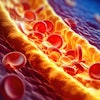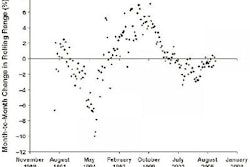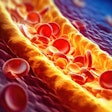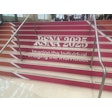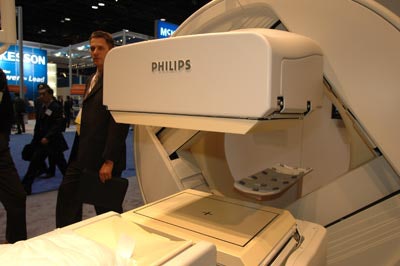
CHICAGO - New product introductions in MRI, digital radiography (DR), and SPECT are among the highlights in the RSNA booth of Andover, MA-based Philips Medical Systems. The company is also touting enhancements in its CT, ultrasound, PACS, and speech recognition business.
MRI
The company is extending its Achieva ultrahigh-field MRI line with a trio of new 3-tesla scanners, called Achieva X-series. The new systems include a novel concept that enables customers to buy a 1.5-tesla scanner that can be upgraded to 3-tesla later without exchanging magnets.
The first system in the series is Achieva 3.0T X-series, which upgrades the previous Achieve 3.0T design with a new magnet, gradient, and radiofrequency coils. The company says the X-series technology provides better performance and a larger field-of-view, and enables clinicians to conduct advanced clinical imaging on a system that's as easy to use as a standard 1.5-tesla magnet.
Features on the system including 2K imaging, 4D-Trak, the company's SENSE parallel imaging protocol, FiberTrak, SENSE Spectroscopy, and diffusion-weighted whole-body imaging with background body signal suppression (DWIBS).
The new X-series family also includes Achieva 3.0T X-series mobile, a mobile version of the platform that has the same functionality as the stationary version, the company said.
In addition, Philips is releasing Achieva XR, a novel concept in which the company delivers a 3-tesla magnet that functions at a 1.5-tesla field strength. The system can be upgraded to 3-tesla later without having to swap out a new magnet, according to the company.
Philips executives say Achieva XR is designed to target a market where some 40% of customers are considering buying a 3-tesla scanner but may not be ready to take the plunge right away. The XR system will carry a price point between a 1.5-tesla scanner and a full 3-tesla system, and will be priced about 25% higher than a standard 1.5-tesla system.
Philips is touting new additions to its SmartExam family of image study automation protocols. SmartExam Spine and SmartExam Knee join SmartExam Brain in the program, and with the new additions SmartExam functionality will soon be available for the majority of clinical applications for which MRI is used. SmartExam applications are available as options, and the company will begin taking orders for the knee version in January and the spine application in mid-2007.
Finally, Philips is promoting the new RF coils available through its acquisition of coil developer Invivo of Orlando, FL. The company is showing 16 new coils on the RSNA technical exhibit floor.
Molecular imaging
Philips is giving its SPECT platform a new look with the launch of BrightView, a variable-angle dual-head gamma camera. The camera features an open design and is scalable, enabling users to start with an entry-level system and scale up to a more advanced design.
Philips is touting the camera's CloseUp technology, which enables users to move the system's detector heads extremely close to patients, while the system's BodyGuard technique employs an autobody contouring technique based on electrical fields to move the heads away from patients when it senses they are too close.
BrightView also features a table that supports patients weighing up to 450 lb, and its thin-palette design minimizes attenuation. The camera has system spatial resolution with 3/8-inch crystals of 7.5 mm full-width half-maximum at 10 cm without scatter correction, and 7.8 mm with scatter correction. Employing the company's proprietary Astonish reconstruction improves resolution to 5.8 mm.
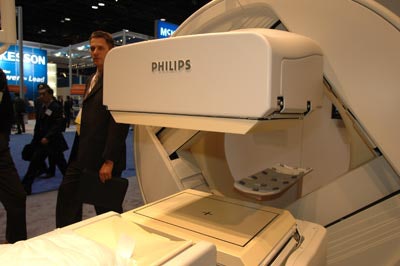 |
| Philips is featuring BrightView, a variable-angle dual-head gamma camera, in its booth at this year's RSNA. |
BrightView will begin shipping in the second quarter of 2007. Philips is also developing a new attenuation correction localization technology for the system.
On the PET/CT side, Philips is showcasing the Gemini TF system with the company's TruFlight time-of-flight technology. First available in a 16-slice model, Philips last week began shipping a 64-slice version of Gemini TF.
The company is also highlighting a work-in-progress PET/CT viewer that can be accessed through its iSite PACS software, as well as a pulmonary toolkit for respiratory gating studies. Philips is also planning to roll out a version of its Ambient Experience concept for molecular imaging in 2007. Finally, the company is extended its NetForum concept to PET/CT, and has begun collecting members with an eye on making a major launch of the program in mid-2007.
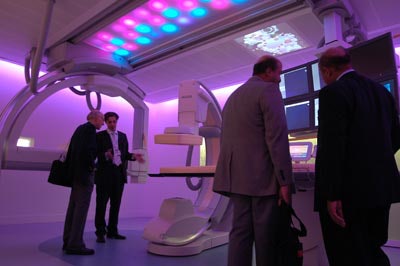 |
| Philips is also showcasing its Ambient Experience molecular imaging concept, targeted for launch in 2007. |
X-ray
Philips is moving its digital radiography product line to the midrange segment with the launch of Essenta DR, a more economical version of the company's DR technology that's designed to target smaller facilities that are converting to DR.
Essenta DR uses the same 17 x 17-inch Trixell digital detector found on other Philips DR systems, and employs a U-arm design for added functionality. The system uses a portable trolley rather than a fixed table, and has motorized movement with safety features based on infrared technology to prevent collisions with patients and technologists.
The system will begin shipping in the second quarter of 2007, and will be priced at about $200,000, about $80,000 to $120,000 less than the company's DigitalDiagnost system.
On DigitalDiagnost, Philips is highlighting a stitching accessory that enables users to conduct long-length images for spine and leg studies. An autopositioning feature for single-detector systems is new on the product as well.
Philips is also touting xLNA Enterprise 2.0, computer-aided detection (CAD) software accessed through the company's alliance with EDDA Technology of Princeton Junction, NJ. The software will be available in the U.S., China, and Europe in the first quarter of 2007.
The company's MultiDiagnost Eleva radiography/fluoroscopy package is getting a new enhancement in the form of 3D-RX, a technology that will enable users to conduct CT-like images. The system rotates around the patient in six seconds at either 15 or 30 frames per second. Philips believes the application will be well-suited for weight-bearing studies not possible in a CT scanner, and will begin shipping by the end of 2007.
Other x-ray enhancements being featured in the company's booth include an autostitching package for its computed radiography systems.
In interventional x-ray, Philips is touting 3D interventional tools on its Allura angiography systems. Dynamic 3D Roadmap integrates live fluoroscopy with a 3D rotational angiography roadmap for catheter and guidewire navigation, while Xper Guide matches on a single display images from the company's XperCT angiography CT tool and live fluoroscopy images. The applications will be available in 2007.
Finally, Philips is discussing the expansion of its Ambient Experience concept to interventional x-ray. The company is walking booth visitors to a sample interventional suite outfitted with Ambient Experience technology, such as mood lighting, overhead video screens, and adjustable privacy screens between the scanning suite and the console room.
CT
In the CT section of its booth, Philips is promoting new options and features for its Brilliance line of scanners. The company has shipped over 2,500 Brilliance systems, including over 800 64-slice models.
Brilliance Everywhere is designed to help users to manage large CT datasets. Available as an option on version 3.5 of the Extended Brilliance Workspace software, the technology enables users to employ advanced CT viewing and data manipulation tools to any PC in a healthcare enterprise, or to a connected PC at home.
Also being promoted is a new cardiac imaging mode designed to reduce dose. Called Step & Shoot mode, the application moves the CT detector in four steps over the heart to collect axial scans at the optimal point in the cardiac cycle. The system's x-ray beam is turned off when not needed, resulting in much lower radiation dose, according to the company. Philips hopes to be able to produce routine cardiac scans with patient dose in the range of 3 mSv. Step & Shoot will begin shipping at the end of 2007.
TrueView is a new CT application that enables integration with cardiac cath labs using flat-panel digital detectors. The application is useful in situations in which CT can provide additional information, and the software automatically synchronizes the display of CT and cath data. TrueView is currently in beta testing and will be available in 2007.
Philips is also discussing its Big Bore line of CT scanners with 85-cm bores. The company launched a version of the Big Bore line for bariatric applications in July, and the system is available with a 650-lb table weight.
IT/PACS
Philips also is showcasing its iSite PACS, highlighting enhancements that feature the ability to transmit as many as 350 images in less than three seconds.
iSite technology allows all users to navigate through large and volumetric datasets without having to download a full dataset first, and to operate on existing networks rather than separate, dedicated infrastructures.
Philips' RSNA emphasis is on iSite's addition of iSyntax 3D technology with 3D advanced visualization tools and its ability to better handle advanced clinical applications. iSyntax integration offers enterprise-wide access to slab multiplanar reformatting (MPR), maximum intensity projection (MIP), and advanced volume visualization.
Philips plans for an early 2007 release for its iSite advanced visualization.
With iSite PACS allows access with a healthcare institution can give all caregivers within the enterprise access to these clinical visualization tools and applications, utilizing its high performance iSyntax distribution technology and the iSite Platform API.
Philips' also is displaying the upgraded 2.1 version of its Xcelera cardiovascular information management system, scheduled for release in January 2007. Xcelera's single workspace is designed to provide access to all cardiovascular information and assist radiologists and cardiologists with clinical tools for both CT and MR cardiac image analyses.
Ultrasound
In ultrasound, Philips' primary platform, the iU22, is taking center stage at the RSNA show. With its Vision 2007 upgrade, iU22 ultrasound systems expand their volumetric imaging capabilities, add tools for interventional procedures, and enhance workflow protocols.
Philips notes that customizable protocol-driven exams have been clinically proven to reduce some ultrasound exam times by as much as 30% and improve exam consistency, as the technology guides the user through the process, annotates one image, and moves to the next image. New image enhancements also are designed to optimize needle visualization for less invasive biopsy procedures and assist in planning, guiding, and assessing liver tumor ablations.
With its RSNA launch, Philips will begin shipments of its iU22 ultrasound systems with Vision 2007.
Speech recognition
Philips' SpeechMagic voice recognition technology offers 14 new features.
Philips FIMI showcases its ProScribe, which the company describes as a shock and water resistant cordless display with embedded wireless thin client technology. Powered by SpeechMagic, PowerScribe is designed to enhance the accuracy and efficiency of medical documentation.
As SpeechMagic progresses, Nick van Terheyden, chief medical officer and director of business development for Philips Speech Recognition Systems of Vienna, Austria, sees the technology advancing toward a "tighter integration into workflow and with the medical knowledge base" to capture data and collaborate with an existing RIS/PACS.
By Brian Casey and Wayne Forrest
AuntMinnie.com staff writers
November 27, 2006
Copyright © 2006 AuntMinnie.com

